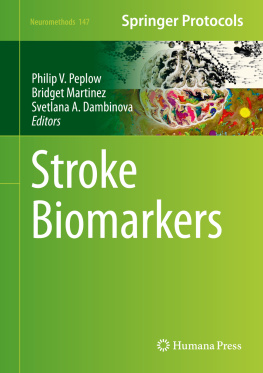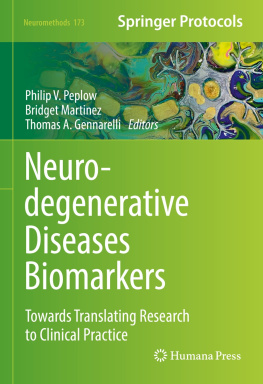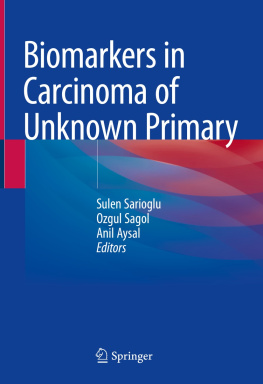Philip V. Peplow - Stroke Biomarkers
Here you can read online Philip V. Peplow - Stroke Biomarkers full text of the book (entire story) in english for free. Download pdf and epub, get meaning, cover and reviews about this ebook. year: 2020, publisher: Springer New York, genre: Home and family. Description of the work, (preface) as well as reviews are available. Best literature library LitArk.com created for fans of good reading and offers a wide selection of genres:
Romance novel
Science fiction
Adventure
Detective
Science
History
Home and family
Prose
Art
Politics
Computer
Non-fiction
Religion
Business
Children
Humor
Choose a favorite category and find really read worthwhile books. Enjoy immersion in the world of imagination, feel the emotions of the characters or learn something new for yourself, make an fascinating discovery.
- Book:Stroke Biomarkers
- Author:
- Publisher:Springer New York
- Genre:
- Year:2020
- Rating:5 / 5
- Favourites:Add to favourites
- Your mark:
- 100
- 1
- 2
- 3
- 4
- 5
Stroke Biomarkers: summary, description and annotation
We offer to read an annotation, description, summary or preface (depends on what the author of the book "Stroke Biomarkers" wrote himself). If you haven't found the necessary information about the book — write in the comments, we will try to find it.
Stroke Biomarkers — read online for free the complete book (whole text) full work
Below is the text of the book, divided by pages. System saving the place of the last page read, allows you to conveniently read the book "Stroke Biomarkers" online for free, without having to search again every time where you left off. Put a bookmark, and you can go to the page where you finished reading at any time.
Font size:
Interval:
Bookmark:

For further volumes: http://www.springer.com/series/7657
Neuromethods publishes cutting-edge methods and protocols in all areas of neuroscience as well as translational neurological and mental research. Each volume in the series offers tested laboratory protocols, step-by-step methods for reproducible lab experiments and addresses methodological controversies and pitfalls in order to aid neuroscientists in experimentation. Neuromethods focuses on traditional and emerging topics with wide-ranging implications to brain function, such as electrophysiology, neuroimaging, behavioral analysis, genomics, neurodegeneration, translational research and clinical trials. Neuromethods provides investigators and trainees with highly useful compendiums of key strategies and approaches for successful research in animal and human brain function including translational bench to bedside approaches to mental and neurological diseases.

Cover illustration: This custom piece was created by Dr. Bridget Martinez and Donald Mario Robert Harker; using acrylic paint on canvas with the addition of graphic design.
This Humana imprint is published by the registered company Springer Science+Business Media, LLC, part of Springer Nature.
The registered company address is: 233 Spring Street, New York, NY 10013, U.S.A.

This custom piece was created by Dr. Bridget Martinez and Donald Mario Robert Harker; using acrylic paint on canvas with the addition of graphic design
This artistic rendition encapsulates the hemispherical dominances in a visual capacity. Whereas one represents an objective, linear, logical, analytical and sequential school of thought, the other reveals itself to be less reasonable and dabbles in the idiosyncrasies of subjectivity by manifesting itself as a holistic network invoking an emotional, more intuitive and creative thought. Yet whether it is the poet or the accountant which dominates in each of us, it has become increasingly clear that the complete absence of either, leaves one in a universe devoid of both rhyme and reason.
This book is dedicated to our universe which inspires, challenges, creates, and molds beauty, even from the most unexpected corners and circumstances. The pursuit of knowledge is a great adventure. In loving memory of my father Elmer Martinez. Endless gratitude to my mother Eda Noguera, my sister Karla Zeo Sanchez, and my brother Elmer Martinez.
Bridget Martinez
The world is still a beautiful place and full of kindness and love. I wish to dedicate this book to Bridget who is a shining light and inspiration in my life and also to my family, friends, and colleagues for their support and encouragement.
Philip V. Peplow
In memory of Robert Rose Rhinehart, a strong believer in a great future of brain biomarkers and constant support.
Svetlana A. Dambinova
Experimental life sciences have two basic foundations: concepts and tools. The Neuromethods series focuses on the tools and techniques unique to the investigation of the nervous system and excitable cells. It will not, however, shortchange the concept side of things as care has been taken to integrate these tools within the context of the concepts and questions under investigation. In this way, the series is unique in that it not only collects protocols but also includes theoretical background information and critiques which led to the methods and their development. Thus, it gives the reader a better understanding of the origin of the techniques and their potential future development. The Neuromethods publishing program strikes a balance between recent and exciting developments like those concerning new animal models of disease, imaging , in vivo methods, and more established techniques, including, immunocytochemistry and electrophysiological technologies. New trainees in neurosciences still need a sound footing in these older methods in order to apply a critical approach to their results.
Under the guidance of its founders, Alan Boulton and Glen Baker, the Neuromethods series has been a success since its first volume published through Humana Press in 1985. The series continues to flourish through many changes over the years. It is now published under the umbrella of Springer Protocols. While methods involving brain research have changed a lot since the series started, the publishing environment and technology have changed even more radically. Neuromethods has the distinct layout and style of the Springer Protocols program, designed specifically for readability and ease of reference in a laboratory setting.
The careful application of methods is potentially the most important step in the process of scientific inquiry. In the past, new methodologies led the way in developing new disciplines in the biological and medical sciences. For example, Physiology emerged out of Anatomy in the nineteenth century by harnessing new methods based on the newly discovered phenomenon of electricity. Nowadays, the relationships between disciplines and methods are more complex. Methods are now widely shared between disciplines and research areas. New developments in electronic publishing make it possible for scientists who encounter new methods to quickly find sources of information electronically. The design of individual volumes and chapters in this series takes this new access technology into account. Springer Protocols makes it possible to download single protocols separately. In addition, Springer makes its print-on-demand technology available globally. A print copy can therefore be acquired quickly and for a competitive price anywhere in the world.
Font size:
Interval:
Bookmark:
Similar books «Stroke Biomarkers»
Look at similar books to Stroke Biomarkers. We have selected literature similar in name and meaning in the hope of providing readers with more options to find new, interesting, not yet read works.
Discussion, reviews of the book Stroke Biomarkers and just readers' own opinions. Leave your comments, write what you think about the work, its meaning or the main characters. Specify what exactly you liked and what you didn't like, and why you think so.









